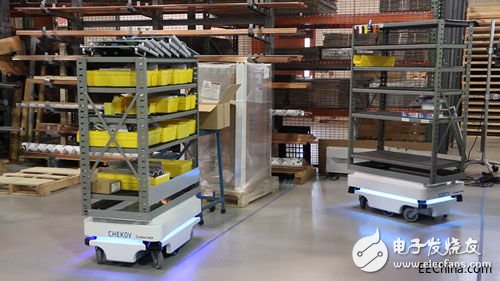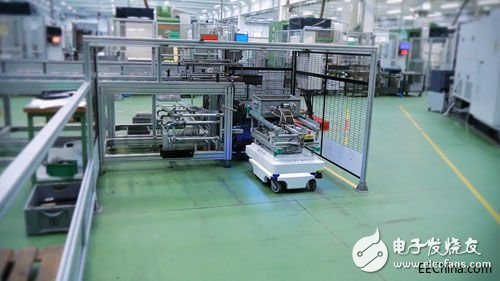Lean manufacturing has been launched by major manufacturers, and executives are evaluating opportunities to continue to optimize productivity. Even in highly automated plants, in many cases, material handling still requires manpower and is very inefficient. Automating material transportation to reduce production bottlenecks and deploy critical human resources more effectively has always been a challenging and difficult problem. Business decision makers are stunned by the expensive Automated Guided Vehicle System (AGV) because this AGV does not provide the flexibility needed for today's agile production processes. However, in this unpredictable and ever-changing production layout and dynamic working environment, new sensors and software technologies are making autonomous mobile robots (AMR) an ideal solution.
Agile production enables companies to adapt to rapidly changing market demands and remain competitive, but achieving on-time delivery of materials and components in production plants remains a challenge that cannot be underestimated. Manual transportation means that workers need to leave their jobs, push carts filled with materials, and travel to and from the production halls and warehouses, which can lead to extrusion time and the need for workers to wait for components and parts to be delivered. Labor idleness. Achieving this automated delivery has always been a challenge. The production layout of the factory is usually dynamic, and new production units and processes will continue to appear, and obstacles such as personnel, equipment, and pallets will appear on the open passages from time to time. Any automated material handling method needs to be extremely flexible and adaptable without incurring additional costs or disruption of the production process, not to mention ensuring the safety of the employees. This flexibility also means that automated material handling mechanisms must be easy to learn, program, deploy, and internally redeploy to ensure that the chosen method is affordable and adaptable to the latest requirements.
The traditional Automated Guided Vehicle System (AGV) uses a fixed route for transporting materials and is guided by the installation of permanent wires, magnetic strips or sensors embedded in the factory floor. However, such systems are very rigid, expensive, and very unsuitable for production environments that require frequent adjustments. If there is any change in the production process, the production environment needs to be re-adjusted to ensure the normal operation of the AGV. And if there is a person or material temporarily blocking the AGV's driving path, it will stop moving forward until the road is smooth. In contrast, autonomous mobile robots (AMRs) are developed for dynamic production environments with full flexibility, safety and cost-effectiveness to automate and optimize material handling for businesses of virtually any size.
Onboard intelligence system ensures easy integration and fast return on investmentAMR navigates through the robot's own built-in sensors, cameras and complex software without the need for external sensors or guidance. Once the robot knows the surrounding environment (by uploading the factory blueprint or letting the robot visit the factory to generate the map), it can automatically identify the surrounding conditions, take the most convenient and efficient path, automatically advance to the destination, safely avoid all obstacles and flow personnel. At the same time, the robot can be integrated in just a few hours, without disrupting the factory production, and the company does not need to use wires or sensors to renovate the plant.

Magna-Power, a New Jersey-based power product manufacturer, deployed two MiR autonomous mobile robots to help them complete the transportation of parts and components in warehouse and vertically integrated production facilities. AMR is easy to deploy, so it only takes hours to get into operation. Adam Pitel, vice president of operations at Magna-Power, exclaimed: "After receiving the MiR autonomous mobile robot, we took about 15 minutes to unpack and put them on the ground, and after another 15 minutes, I was able to pass my own The mobile phone is remotely commanding it. At the same time, within two hours, after I uploaded the factory schematic to the robot system, they can carry out the point-to-point transportation in our building. I am very surprised by the ease and speed of use!"
MiR's autonomous mobile robots can be quickly and easily integrated, so productivity gains can be achieved almost immediately. It is no exaggeration to say that the initial cost of autonomous mobile robots is very low, and the process is optimized quickly, usually with a return on investment of less than six months.
High flexibility and optimized productivityAMR is able to increase the operational efficiency associated with production and material handling. And even if the business volume continues to grow, the expansion cost of new AMR applications is extremely low. In addition, AMR is collaborative, replacing any work that workers push carts to transport materials or deliver shipments, and by automating these low value-added jobs, employees are more focused on high value-added jobs. After deploying two AMRs, Magna-Power has liberated the equivalent of three full-time workers. But using robots is not meant to replace workers, but to enable workers to use time more efficiently, focusing on jobs that robots cannot do.

AMR performs a monotonous and repeatable material transport job smoothly and without interruption, without disturbing the assembly process. NewForm, an Italian manufacturer of high-end bathtub faucets and accessories, has achieved the same benefits after deploying two mobile robots. The automated loading and unloading of mobile robots keeps the production line running 24/7. In addition, by integrating AMR with the plant's production planning system, real-time overview of material transport is possible, ensuring production control in real time. MiR's autonomous mobile robot software makes it easy to communicate with manufacturing tools and data servers, easily tracking each accessory and seeing its location and status in real time.
In today's labor market, which is in short supply, modern manufacturing companies obviously cannot rely on expensive and rigid traditional technologies, and they cannot afford the low-efficiency operation of human transportation. The advent of autonomous mobile robots provides a more agile alternative to AGV or manual transport, and is a new partner for lean manufacturing through high flexibility, cost effectiveness, return on investment and productivity optimization.
multi-in and multi-out connector
5 Pins Lamps Connector ,Circuit Screwless Connector For Led Lighting Connector,Multi-In And Multi-Out Lamps Connector
Guangdong Ojun Technology Co., Ltd. , https://www.ojunconnector.com